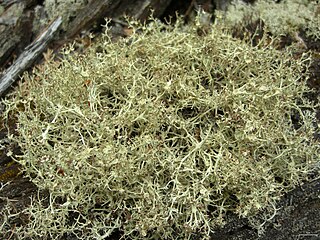
Cladonia rangiferina, also known as reindeer cup lichen, reindeer lichen or grey reindeer lichen, is a light-colored fruticose, cup lichen species in the family Cladoniaceae. It grows in both hot and cold climates in well-drained, open environments. Found primarily in areas of alpine tundra, it is extremely cold-hardy.

Cladonia is a genus of moss-like lichens in the family Cladoniaceae. They are the primary food source for reindeer/caribou. Cladonia species are of economic importance to reindeer-herders, such as the Sami in Scandinavia or the Nenets in Russia. Antibiotic compounds are extracted from some species to create antibiotic cream. The light green species Cladonia stellaris is used in flower decorations.

Cladonia portentosa, also known as reindeer lichen or the cream cup lichen, is a light-coloured, fruticose, cup lichen in the family Cladoniaceae.

Cladonia asahinae, the pixie cup lichen or Asahina's cup lichen, is a species of cup lichen in the Cladoniaceae family. It grows on moss, particularly Chorisodontium aciphyllum, Polytrichum strictum, and Andreaea species. C. asahinae occurs in Europe, North America, and the southernmost part of South America. It also grows in the Antarctic.

Cladonia fimbriata or the trumpet cup lichen is a species cup lichen belonging to the family Cladoniaceae.

Cladonia cristatella, commonly known as the British soldiers lichen or the British soldiers cup lichen, is a fruticose, cup lichen belonging to the family Cladoniaceae. The species was first described scientifically by American botanist Edward Tuckerman in 1858.

Cladonia stellaris or the star-tipped cup lichen is an ecologically important species of cup lichen that forms continuous mats over large areas of the ground in boreal and arctic regions around the circumpolar north. The species is a preferred food source of reindeer and caribou during the winter months, and it has an important role in regulating nutrient cycling and soil microbiological communities. Like many other lichens, Cladonia stellaris is used by humans directly for its chemical properties, as many of the secondary metabolites are antimicrobial, but it also has the unique distinction of being harvested and sold as 'fake trees' for model train displays. It is also used as a sound absorber in interior design.

Cladonia parasitica, commonly known as the fence-rail cladonia, fence-rail cup lichen or parasite club lichen, is a species of fruticose, cup lichen in the family Cladoniaceae. It was first described by Hoffmann in 1784 under the name Lichen parasiticus, until he reclassified it under the genus Cladonia in 1795.

Cladonia amaurocraea, commonly known as the quill lichen or the quill cup lichen, is a species of fruticose, cup lichen in the Cladoniaceae family.

Cladonia arbuscula or the shrubby cup lichen is a species of cup lichen in the Cladoniaceae family.

Cladonia deformis, also known as the lesser sulphur cup or the lesser sulphur cup lichen, is a light-coloured, fruticose, cup lichen belonging to the family Cladoniaceae. This lichen was first described as Lichen deformis by Carl Linnaeus in 1753, and transferred to the genus Cladonia in 1796 by Georg Franz Hoffmann.

Cladonia coniocraea, commonly known as the common powderhorn or the powderhorn cup lichen, is a species of fruticose, cup lichen in the family Cladoniaceae. It was first described by Heinrich Gustav Flörke in 1821 under the name Cenomyce coniocraea, until Kurt Polycarp Joachim Sprengel reclassified it under the genus Cladonia in 1827.

Cladonia coccifera or madame's cup lichen is a species of fruticose, cup lichen in the family Cladoniaceae. It was first described by Swedish lichenologist Carl Linnaeus in his 1753 work Species Plantarum. German botanist Carl Ludwig Willdenow transferred it to the genus Cladonia in 1787. The lichen has apothecia and bright red pycnidia atop of yellowish to grey-green podetia that are 1–2 cm (0.4–0.8 in) high. The base of the thallus comprises rounded squamules (scales) with a yellow to orange-brown undersurface. It typically occurs on acidic peaty and sandy soils.

Cladonia uncialis is a species of fruticose, cup lichen in the family Cladoniaceae. It was first described as a new species by Swedish taxonomist Carl Linnaeus in 1753. It was transferred to the genus Cladonia by Friedrich Heinrich Wiggers in 1780. In North America, the lichen is colloquially known as the thorn Cladonia or the thorn cup lichen.

Cladonia glauca or the glaucous cup lichen is a species of fruticose, cup lichen in the family Cladoniaceae. Found in Europe, it was formally described as a new species in 1828 by German botanist Heinrich Gustav Flörke. The nematodes Aphelenchoides lichenicola and Ottolenchus cabi feed on this lichen.

Cladonia macilenta or the lipstick cup lichen is a species of cup lichen in the family Cladoniaceae.

Cladonia strepsilis or the olive cup lichen is a species of cup lichen in the family Cladoniaceae. In Iceland, where it is only found in a few locations in the Eastern Region, it is red listed as endangered (EN).
Lichenoconium pyxidatae is a species of lichenicolous fungus belonging to the class Dothideomycetes. It has a Holarctic distribution being found in Alaska and various parts of Russia, including Siberia, Franz Josef Land, Novaya Zemlya and Wrangel Island.

Cladonia sulphurina is a species of cup lichen belonging to the family Cladoniaceae.
Cladonia homosekikaica is a species of cup lichen belonging to the family Cladoniaceae. It was formally described as a new species by Japanese lichenologist Mariko Nuno in 1975.


















